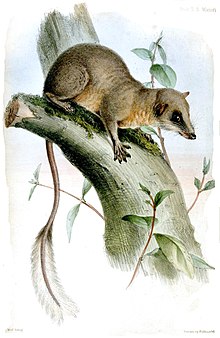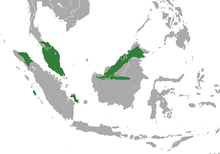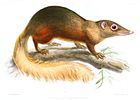| Pen-tailed treeshrew | |
|---|---|

| |
| Illustration in 1848 species description | |
| Conservation status | |
 Least Concern (IUCN 3.1) | |
| CITES Appendix II (CITES) | |
| Scientific classification | |
| Domain: | Eukaryota |
| Kingdom: | Animalia |
| Phylum: | Chordata |
| Class: | Mammalia |
| Order: | Scandentia |
| Family: | Ptilocercidae |
| Genus: | Ptilocercus |
| Species: | P. lowii |
| Binomial name | |
| Ptilocercus lowii J. E. Gray, 1848 | |

| |
| Pen-tailed treeshrew range | |
The pen-tailed treeshrew (Ptilocercus lowii) is a treeshrew of the family Ptilocercidae native to southern Thailand, the Malay Peninsula, Borneo, and some Indonesian islands.
It is the only living species in the genus Ptilocercus. All other treeshrew species are grouped in the family Tupaiidae.
Distribution and habitat
The pen-tailed treeshrew occurs from southern Thailand and the Malay Peninsula to northern Sumatra, Siberut, Bangka Island and northwestern Borneo. It inhabits foremost primary forest up to an elevation of 1,200 m (3,900 ft), where undergrowth is dense.
Behaviour and ecology
See also: Venom § Venom resistant animalsPen-tailed treeshrews studied in Malaysia spent several hours per night consuming naturally fermented nectar of the bertam palm. This nectar contains one of the highest alcohol concentrations of all natural foods. The pen-tailed treeshrews did not show any signs of intoxication, although they frequently consumed large amounts of this nectar, equivalent of 10–12 glasses of wine adjusted to body weight with an alcohol content up to 3.8%. Measurements of a biomarker of alcohol dehydrogenase suggest that they may be metabolizing it by a pathway that is not used as heavily by humans. Their ability to ingest high amounts of alcohol is hypothesized to have been an evolutionary adaptation. How pen-tailed treeshrews benefit from this alcohol ingestion or what consequences of consistent high blood alcohol content might factor into their physiology is unclear.
Taxonomy and evolutionary history
The Ptilocercidae are a family within the order Scandentia. Numerous morphological and genetic differences support the classification of the Ptilocercidae as a separate family from the rest of the treeshrews which diverged around 60 million years ago. Treeshrews are considered very close relatives of primates, with the colugos being closer to primates.
References
- ^ Helgen, K.M. (2005). "Ptilocercus lowii". In Wilson, D.E.; Reeder, D.M (eds.). Mammal Species of the World: A Taxonomic and Geographic Reference (3rd ed.). Johns Hopkins University Press. pp. 108–109. ISBN 978-0-8018-8221-0. OCLC 62265494.
- ^ Cassola, F. (2016). "Ptilocercus lowii". IUCN Red List of Threatened Species. 2016: e.T41491A22278277. doi:10.2305/IUCN.UK.2016-2.RLTS.T41491A22278277.en. Retrieved 26 January 2022.
- Wiens, F.; Zitzmann, A.; Lachance, M.-A.; Yegles, M.; Pragst, F.; Wurst, F. M.; von Holst, D.; Guan, S. L. & Spanagel, R. (2008). "Chronic intake of fermented floral nectar by wild tree-shrews". Proceedings of the National Academy of Sciences. 105 (30): 10426–10431. Bibcode:2008PNAS..10510426W. doi:10.1073/pnas.0801628105. PMC 2492458. PMID 18663222.
- ^ Janečka; J. E.; Miller, Thomas W.; Pringle, H.; Wiens, F.; Zitzmann, A.; Helgen, K. M.; Springer, M. S.; Murphy, W. J (2007). "Molecular and Genomic Data Identify the Closest Living Relative of Primates". Science. 318 (5851): 792–794. Bibcode:2007Sci...318..792J. doi:10.1126/science.1147555. PMID 17975064. S2CID 12251814.
- Roberts, T.E.; Lanier, H.C.; Sargis, E.J.; Olson, L.E. (2011). "Molecular phylogeny of treeshrews (Mammalia: Scandentia) and the timescale of diversification in Southeast Asia". Molecular Phylogenetics and Evolution. 60 (3): 358–372. Bibcode:2011MolPE..60..358R. doi:10.1016/j.ympev.2011.04.021. PMID 21565274.
External links
| Euarchontoglires | |||||||||||||||||||||||||||||||||||||||||||||||
|---|---|---|---|---|---|---|---|---|---|---|---|---|---|---|---|---|---|---|---|---|---|---|---|---|---|---|---|---|---|---|---|---|---|---|---|---|---|---|---|---|---|---|---|---|---|---|---|
| |||||||||||||||||||||||||||||||||||||||||||||||
| |||||||||||||||||||||||||||||||||||||||||||||||
| |||||||||||||||||||||||||||||||||||||||||||||||
| |||||||||||||||||||||||||||||||||||||||||||||||
| Taxon identifiers | |
|---|---|
| Ptilocercus lowii | |
This article about a mammal is a stub. You can help Misplaced Pages by expanding it. |




